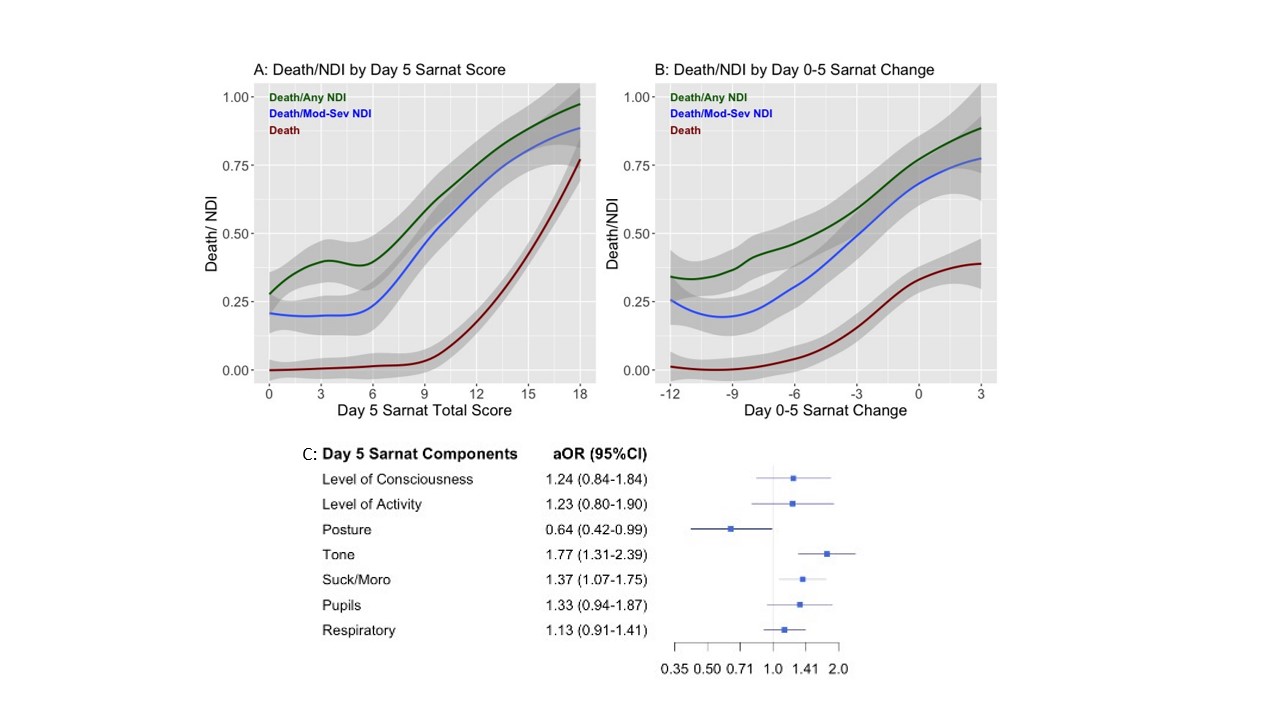Neonatal Neurology: Clinical Research
Neonatal Neurology 3: Clinical 3
184 - Change in SARNAT Score after Rewarming predicts Outcomes in Infants with moderate or severe Hypoxic Ischemic Encephalopathy (HIE)
Publication Number: 184.137

Sarah E. Kolnik, MB MBA (she/her/hers)
Assitant Professor of Pediatrics
University of Washington - Seattle Children's Hospital
Seattle, Washington, United States
Presenting Author(s)
Background: Attempts to predict neurodevelopmental impairment (NDI) or death in neonates with moderate or severe HIE undergoing therapeutic hypothermia using the Sarnat exam (SE) remain inconclusive. A paucity of data exists regarding optimal timing of exam and the contribution of each subcategory to predicting outcome.
Objective:
We hypothesized that the modified SE performed after rewarming, and the evolution of Sarnat category from initial exam to rewarming, would predict outcome, with differing contributions of the individual components.
Design/Methods:
This is a secondary analysis of the High-Dose Erythropoietin for Asphyxia and encephaLopathy (HEAL) Trial. All sites used the same modified SE after standardized training. Infants with both a day 0 (D0) and day 5 (D5) SE were included (479/500). The primary outcome was death or any NDI at 22-36 months of age. Adjusted odds ratios (aORs) for death/NDI based on D5 SE severity category, change in category, and the individual components, were constructed, adjusting for ECMO and sedation at time of exam. Absolute D5 Sarnat score and change in score were compared against risk of death/NDI using locally estimated scatterplot smoothing (LOESS) curves.
Results:
Between D0 and D5, the SE improved in 360 (75.2%) and remained the same or worsened in 119 (24.8%) neonates (Table 1). Infants with moderate and severe SE on D5 had an increased aOR for primary outcome (aOR 6.2, 95%CI:31-12.6 and aOR 50.3; 95%CI:13.3-190) compared to those with a normal SE (Fig. 1A). Neonates who remained in the moderate or severe category on D5 had an increased aOR (3.1-53.6) for primary outcome, compared to those who improved, even when initially severe (Fig. 1B). Total numeric score on D5 SE was associated with death/any NDI (Fig. 2A), with an aOR 1.22 (95% CI: 1.16-1.29) per each unit increase in total score (p< 0.001). An improved change in score from D0 to D5 was associated with better outcome compared to those whose total score remained the same or increased (Fig. 2B). Each unit decrease in total Sarnat score from D0 to D5 was associated with an aOR for death/any NDI of 0.85 (95% CI: 0.81-0.90; p< 0.001). Of the six categories, primitive reflexes (aOR1.77, 95% CI:1.31-2.39) and muscle tone (aOR1.37, 95%CI:1.07-1.75) on D5 SE were associated with death/NDI after adjusting for the other categories (Fig. 2C).
Conclusion(s): SE after rewarming and change in SE between D0 and D5 predict NDI/Death at 22-36 months in infants with moderate or severe HIE. Future studies weighing the predictive value of each component of the SE may help modify the scoring system and create predictive models. .jpg)
.jpg)

